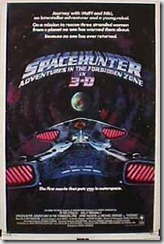Well, this will date me a bit, but when I was 16 years old I remember going in to the city to see ‘Spacehunter: Adventures in the Forbidden Zone’. It was 1983, and there weren’t many 3D movies out there especially any that a teen could see anyways. My friends and I donned our white paper 3D glasses and sat through an hour and a hal f of sci-fi cheese. And I have to say I get the same impression a lot of the time now when I see 3D in the theater. Technology has improved but the word that comes to mind is ‘Gimmick’. Sure it enhances some types of productions and events but for the most part it’s not exactly color to black and white.
f of sci-fi cheese. And I have to say I get the same impression a lot of the time now when I see 3D in the theater. Technology has improved but the word that comes to mind is ‘Gimmick’. Sure it enhances some types of productions and events but for the most part it’s not exactly color to black and white.
Don’t get me wrong – It is going to be more and more prevalent and more and more immersive in the coming years – and the hardware, resolution, and viewing aids less intrusive. But there are some fundamental problems with 3D that are going to prevent it from being mainstream.
1) 2D Conventions don’t always translate well to 3d. Cinema and television, have up until now been the art of taking a 3D world, and mapping it to two dimensions – on to a 2D viewport. Things you see such as depth of field blur and focus, changing camera angles whether sudden or faded, rack focus, and various other 2D side effects or methods simply cause problems or are unnatural in stereo 3D.
2) Eye Strain. For example: Changing from one scene to the other, requires the eyes to either instantly switch depth adjustment (causing eye strain and headaches for some), or if fading it has the same effect, causing confusion as to the depth – the eye can ‘freak out’ not knowing how to focus. Some people get headaches in 3D features even if using non shutter technologies and I believe this is one of the main reasons. Also, overlap in physical depth around the viewer, and that being interpreted by their glasses can cause some of the same problems.
3) Head Gear. Okay, I don’t want to sit in my own family room for any length of time with glasses on. I realize that there will be advances in glasses free technologies, but for now they are just high-res vertical slit prism tricks that have very limited depth. Cool but not too practical. Is a true holographic 3D presentation coming in the future?
4) Viewing Angles, Screen Sizes. Viewing angle is very important for good 3D stereo interpretation, as is the screen size and distance to the viewer. Not as important in a 2D representation.
The thing I learned about stereo 3D is that almost none of the technologies are new – just accessible. E xperiments in polarized, shuttered stereo viewing go back to the 1920s, and anaglyph viewing even further. It’s just that in the digital age, the high resolution high fidelity options are readily available, and that the entertainment industry, and consumer electronics industry, are now proclaiming stereo 3D as the next ‘HD’. We will buy sets, displays, glasses, and buy tickets at a premium price – all to get out from behind our home theaters – which have now caught up to the quality of the megaplex both in detail and sound.
xperiments in polarized, shuttered stereo viewing go back to the 1920s, and anaglyph viewing even further. It’s just that in the digital age, the high resolution high fidelity options are readily available, and that the entertainment industry, and consumer electronics industry, are now proclaiming stereo 3D as the next ‘HD’. We will buy sets, displays, glasses, and buy tickets at a premium price – all to get out from behind our home theaters – which have now caught up to the quality of the megaplex both in detail and sound.
Okay Stereo 3D is cool stuff and I think there are some really fun implementations in gaming, immersive 3D environments like those in Tron Legacy 3D, one of the few films I have seen in recent months that seem to ‘get it’ in terms of 3D and when it’s used best. And I plan on doing more work in stereo 3D in the near future from a CG perspective. The next five blog entries here will explain how to do stereo CG ‘on the cheap’ from animation to compositing, editing and output. I welcome your opinions and comments as we are learning stereo ourselves.
So if you are on the cheap like I am with this experiment, go out and grab some Red/Cyan glasses of decent quality for $3.00 and let’s see how far we can go with it on a simple project. And we will look at the more committed options.





